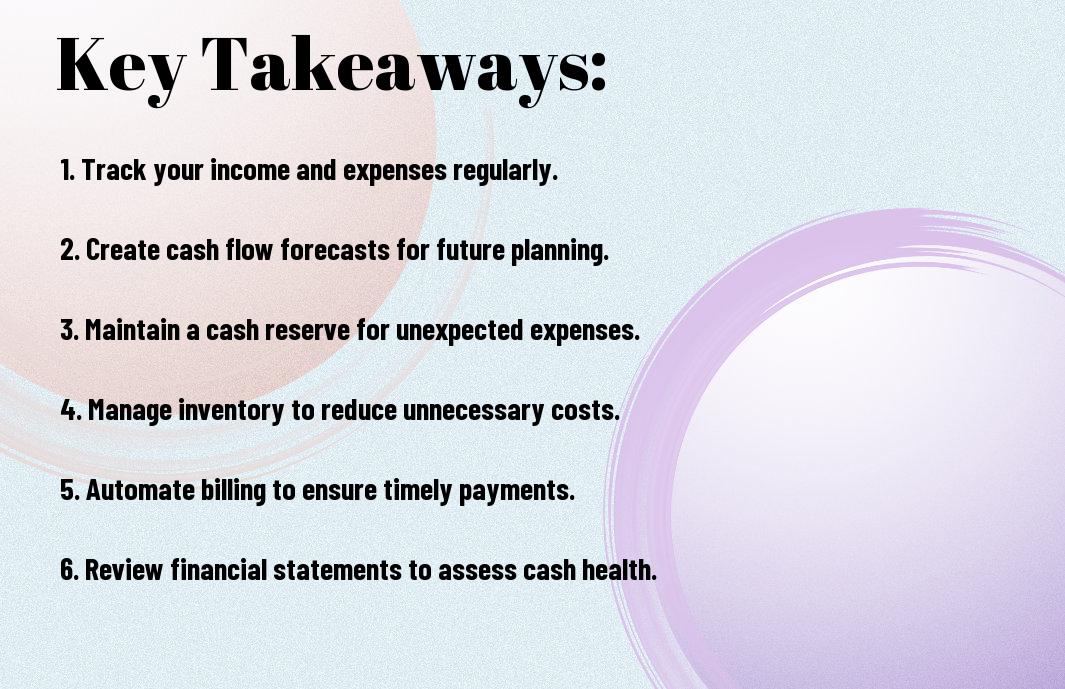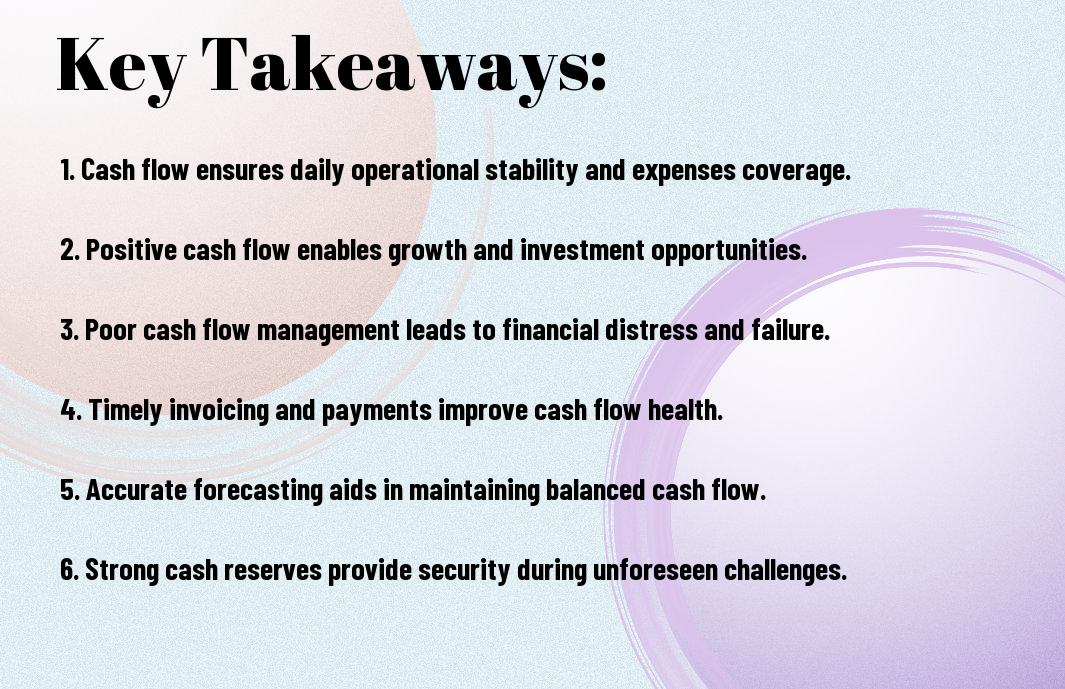Many entrepreneurs face challenges when it comes to managing cash flow as their business expands. Understanding how to effectively monitor and control your cash flow is necessary for sustaining growth and ensuring long-term success. In this blog post, you will discover practical strategies and tips that can help you keep your cash flow healthy, enabling your business to thrive in a competitive landscape.
Key Takeaways:
- Regular Monitoring: Track cash flow consistently to identify trends and potential issues early.
- Accurate Forecasting: Make detailed projections based on historical data to anticipate future cash needs.
- Expense Management: Control expenses by prioritizing necessary costs and reviewing vendor contracts.
- Diverse Revenue Streams: Explore different revenue sources to mitigate risks associated with dependency on a single market.
- Credit Management: Establish clear credit policies to manage customer payments efficiently and reduce delayed receivables.


Understanding Cash Flow
Before you can effectively manage cash flow, you need to grasp what it really means for your business. Cash flow is the movement of money in and out of your business, covering all aspects of your operations, from revenue to expenses. Understanding cash flow will help you make informed decisions about your financial strategies as your business grows.
What is Cash Flow?
At its core, cash flow refers to the net amount of cash being transferred into and out of your business. It includes various sources of income, such as sales revenue, as well as expenditures like payroll and supplier payments. Keeping track of these cash movements will enable you to understand your business’s liquidity and financial health.
Importance of Cash Flow Management
What makes managing cash flow vital for your business is its direct impact on your ability to meet obligations and capitalize on opportunities. Without proper cash flow management, you may find yourself unable to pay bills on time or invest in growth initiatives, which can stunt your business’s potential.
Flow management involves forecasting and tracking cash flows to ensure your business remains solvent. By closely monitoring cash inflows and outflows, you can anticipate shortages and make necessary adjustments, such as optimizing payment terms or analyzing expenses. This proactive approach equips you to navigate financial challenges and seize growth opportunities, ultimately laying a strong foundation for sustainable success.
Assessing Your Current Cash Flow
While understanding your current cash flow situation is crucial for making informed financial decisions, it is equally important for supporting your growing business. You must take a close look at your inflows and outflows to determine whether your business is generating enough cash to cover its operating expenses, investments, and unexpected costs. This assessment will help you pinpoint areas where adjustments may be necessary to ensure financial stability as your business expands.
Analyzing Cash Flow Statements
At the heart of assessing your cash flow is the analysis of cash flow statements. These statements provide a comprehensive overview of your company’s cash inflows and outflows over a specific period. By reviewing these documents, you can identify when cash is being generated and when it is being spent, allowing you to make more informed decisions about expenditures and investments.
Identifying Cash Flow Trends
Against the backdrop of your cash flow statements, identifying trends can provide valuable insights. You’ll want to track your cash flow over different periods to highlight patterns, such as seasonal fluctuations or consistent shortfalls. Understanding these trends enables you to anticipate future challenges and adjust your strategy accordingly.
Another effective way to identify cash flow trends is to compare your current cash flow with previous periods. Look for patterns over the months or quarters to see if your business experiences predictable peaks and troughs. You can also compare your cash flow trends with industry benchmarks to gauge your performance. This analysis will empower you to make strategic decisions, ensuring that you maintain a healthy cash flow as your business continues to grow.
Forecasting Cash Flow
Despite the uncertainties in the market, effective cash flow forecasting is crucial for your business’s growth. By anticipating your financial needs, you can make informed decisions about investments, expenses, and strategic planning. A well-structured forecast allows you to prepare for fluctuations in income and maintain financial stability even during unpredictable times.
Creating Cash Flow Projections
The basis of solid cash flow management lies in creating accurate cash flow projections. Start by analyzing your historical revenue and expenses to identify trends. Then, incorporate seasonal fluctuations, expected sales, and potential changes in your operational costs. This proactive approach not only helps you understand your cash flow patterns but also prepares you for future financial challenges.
Tools and Techniques for Forecasting
To enhance your cash flow forecasting, leverage various tools and techniques that can streamline the process and improve accuracy. Utilize spreadsheet software for customizable projections, or consider specialized cash flow management software that offers advanced features such as automated tracking and real-time updates. Implementing these tools can save you time and provide clearer insights into your financial trajectory.
Indeed, the right tools and techniques for forecasting are vital for maximizing your cash flow efficiency. You can explore software solutions featuring cash flow dashboards, which allow you to visualize trends easily. Additionally, employing scenario analysis enables you to simulate potential changes in revenue and expenses, helping you prepare for various financial outcomes. With consistent review and adjustment, these tools can provide you with a comprehensive view of your business’s financial health, aiding in strategic decision-making.
Managing Receivables and Payables
Unlike larger corporations, you may find that managing receivables and payables requires a more hands-on approach as your business grows. Maintaining a balance between what you owe and what is owed to you is crucial for healthy cash flow. Implementing effective Cash Flow Strategies for Survival can help streamline this process and ensure your business continues to thrive.
Optimizing Your Billing Process
Below, you can enhance your billing process by automating invoicing to ensure timely payments. Utilizing software solutions can help you track invoices and send reminders, thereby reducing outstanding receivables and allowing you to focus on growth.
Managing Supplier Payments
Against a backdrop of limited cash flow, you should establish a payment schedule that aligns with your revenue cycle. This means strategically negotiating terms with suppliers to extend payment periods, which can provide buffer time for cash inflow.
Supplier relationships are integral to your business’s success. By being transparent and communicative about your payment capabilities, you can often negotiate favorable terms that help you maintain a healthy cash flow. Consider discussing discounts for early payments and creating a structured timeline to prioritize which invoices to settle first, ensuring you’re protected without jeopardizing crucial supplies.
Strategies for Improving Cash Flow
For any growing business, implementing effective strategies to enhance cash flow can make a significant difference. This involves closely examining your financial activities and identifying avenues for improvement. By actively managing both your expenses and revenue, you can ensure a healthier cash flow and set your business up for sustainable growth.
Reducing Expenses
Improving your cash flow starts with analyzing and minimizing your expenses. Take a close look at your operating costs, negotiate better terms with suppliers, and eliminate any unnecessary expenditures. Streamlining processes and leveraging technology can also help trim costs without sacrificing quality, ultimately freeing up more cash for reinvestment in your business.
Increasing Revenue Streams
Strategies to boost your cash flow can also involve diversifying your revenue streams. Expanding your product or service offerings can attract new customers and retain existing ones, providing additional income sources. Consider exploring different sales channels, such as online platforms or partnerships. Adjusting pricing strategies and offering bundled services can also stimulate sales and enhance cash flow.
Understanding the various ways to increase your revenue is vital for sustainable growth. Look for opportunities to upsell or cross-sell to existing customers, as this can significantly boost your overall income without incurring substantial additional costs. Additionally, investing in marketing and customer engagement efforts can help attract new clients, while developing subscription models or recurring services can create more predictable cash flow. By diversifying and optimizing your revenue streams, you can build a more resilient financial foundation for your business.
Building a Cash Reserve
Keep a cash reserve to safeguard your business against unexpected expenses and fluctuations in income. A well-prepared cash buffer can help you navigate tough periods without resorting to loans or credit. Check out these 10 Best Practices to Manage Small Businesses Cash Flow to improve your financial resilience.
Importance of a Cash Buffer
Behind every successful business is a thoughtful cash buffer that allows for flexibility and strategic decision-making. This financial cushion can help you avoid disruptions caused by delayed payments or unforeseen expenses, ensuring you maintain operations smoothly.
How to Establish a Cash Reserve
Buffer your business finances by determining the ideal cash reserve amount based on your expenses and sales cycles. Aim for at least three to six months of operating costs in your cash reserve to provide adequate protection. Set aside a consistent percentage of your profits into a dedicated savings account to build this reserve over time.
With discipline and planning, you can establish a cash reserve that grows steadily as your business develops. Set specific savings goals based on your projected monthly expenses, and automate transfers to your reserve account. By prioritizing this practice, you create a financial safety net that empowers you to focus on growth and opportunities without the stress of cash flow interruptions.
Summing up
To wrap up, effectively managing your cash flow as your business grows involves a proactive approach to monitoring your income and expenses. You should routinely analyze your cash flow statements, forecast future cash needs, and maintain a buffer for unexpected costs. Implementing strict invoicing practices and enhancing your collection strategies can ensure timely payments. Additionally, consider diversifying your revenue streams and negotiating favorable terms with suppliers to improve liquidity. By taking these steps, you empower your business to navigate growth while maintaining financial stability.
FAQ
Q: What are the basic steps to analyze cash flow for my growing business?
A: Analyzing cash flow begins with gathering all financial data, including income statements, balance sheets, and cash flow statements. First, track all cash inflows, such as sales revenue and investments. Next, identify cash outflows, which may include operating expenses, taxes, and loan payments. Creating a cash flow forecast by estimating future sales, expected expenses, and timing of cash inflows can help give a clear picture of your financial situation. Regular monitoring of this forecast against actual performance will help identify trends and discrepancies.
Q: How can I improve my cash flow management practices?
A: To enhance cash flow management, consider implementing several strategies. Start by tightening your accounts receivable process; establish clear payment terms, follow up on overdue invoices promptly, and consider offering discounts for early payments. Evaluate your inventory management to avoid excess stock and improve turnover rates. Additionally, regularly review your expenses and look for areas where you can cut costs or negotiate better terms with suppliers. Lastly, maintain a cash reserve to manage any unexpected cash flow shortages effectively.
Q: What financial tools can assist in managing cash flow effectively?
A: Various financial tools can aid in managing cash flow efficiently. Cash flow management software can help automate the tracking, forecasting, and analysis of your cash flow in real time. Accounting software often includes cash flow forecasting features and reporting tools to visualize financial health. Consider using cash flow analysis templates for manual tracking, if preferred. Additionally, engaging with a financial consultant can provide insights into better cash flow management strategies tailored to your business’s unique needs.



